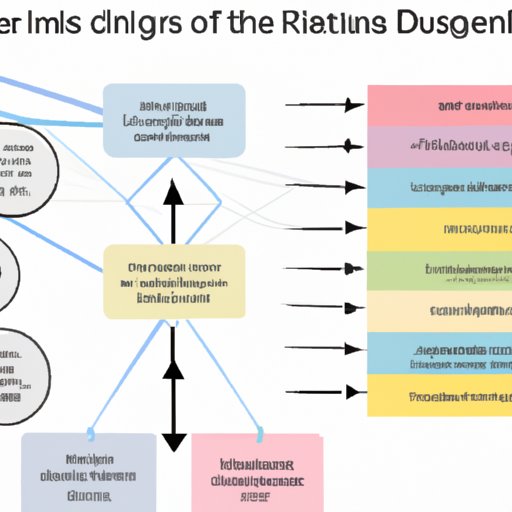Introduction
Good nutrition is essential for overall health and well-being, but it’s not always easy to know what we should be eating. Dietary Reference Intakes (DRIs) provide guidance on how much of each nutrient we need to stay healthy. Understanding how DRIs work and how to use them to optimize your diet can help you make informed decisions about your nutritional needs.
Definition of Dietary Reference Intakes (DRIs)
The Dietary Reference Intakes (DRIs) are a set of reference values that are used to plan and assess nutrient intakes of individuals and groups. They include Recommended Dietary Allowances (RDAs), Estimated Average Requirements (EARs), Adequate Intakes (AIs), Tolerable Upper Intake Levels (ULs), and Acceptable Macronutrient Distribution Ranges (AMDRs). DRIs are developed by the Food and Nutrition Board (FNB) at the Institute of Medicine of the National Academies.
Overview of DRIs and How They Impact Nutritional Needs
DRIs are designed to meet the nutritional needs of nearly all healthy individuals in a population. The RDAs are the average daily dietary intake level sufficient to meet the nutrient requirements of nearly all (97–98%) healthy individuals in a particular life stage and gender group. EARs are the average daily dietary intake level estimated to meet the nutrient requirements of half of the healthy individuals in a particular life stage and gender group. AIs are the recommended average daily nutrient intake levels based on observed or experimentally determined estimates of nutrient intake by a group (or groups) of apparently healthy people.
In addition to providing information on nutrient needs, DRIs also provide guidance on the safe upper limits of nutrient intakes. ULs are the maximum daily intake levels of a nutrient that are unlikely to pose health risks to almost all individuals in the general population. Finally, AMDRs provide guidance on the range of macronutrient intakes that should be consumed as part of a healthy diet.

Exploring the Role of DRIs in Nutrition
DRIs can play an important role in helping people make informed decisions about their nutrition. When used appropriately, DRIs can provide valuable insight into the recommended amounts of nutrients needed for optimal health. Here are some of the key benefits of using DRIs for nutrition:
Benefits of Meeting DRI Recommendations for Nutrients
Meeting DRI recommendations for nutrients can help ensure that you get enough of the essential vitamins and minerals your body needs for optimal health. It can also help reduce the risk of developing certain chronic diseases, such as heart disease and diabetes, by ensuring that you are consuming the right balance of macronutrients.
Understanding How DRIs are Established and Updated
DRIs are established and updated based on the latest scientific evidence available. The FNB reviews and evaluates new research on a regular basis, and updates the DRIs accordingly. This ensures that the latest nutritional guidelines are based on the most up-to-date information.
Interpreting DRIs for Personalized Nutrition
DRIs are only intended to provide general guidance and should not be used as a one-size-fits-all approach to nutrition. While DRIs provide useful information about the recommended amounts of nutrients needed for optimal health, individual needs may vary depending on age, gender, activity level, and other factors. Therefore, it’s important to consult with a healthcare provider to determine your specific nutritional needs.

Uncovering the Link Between DRIs and Macronutrient Balance
Macronutrients, including carbohydrates, proteins, and fats, play a major role in overall health and wellness. Consuming the right balance of macronutrients is essential for optimal health, and DRIs can help you achieve this balance. Here’s a look at the role of macronutrients and how DRIs can help you optimize your diet for optimal health.
The Role of Macronutrients and Their Impact on Health
Carbohydrates, proteins, and fats are the three major types of macronutrients. All three are important for good health and should be included in your diet. Carbohydrates provide energy, while proteins and fats are important for growth and development. Eating the right balance of macronutrients can help maintain weight, improve energy levels, and reduce the risk of certain chronic diseases.
Using DRIs to Optimize Your Diet for Optimal Health
DRIs can help you ensure that you are getting the right balance of macronutrients in your diet. For example, the Acceptable Macronutrient Distribution Range (AMDR) provides guidance on the range of macronutrient intakes that should be consumed as part of a healthy diet. By adhering to the recommended AMDR, you can ensure that you are meeting your nutritional needs and optimizing your diet for optimal health.
Conclusion
Good nutrition is essential for overall health and well-being, and DRIs can help you make informed decisions about your nutritional needs. DRIs provide guidance on the recommended amounts of nutrients needed for optimal health, as well as the safe upper limits of nutrient intakes. They also provide advice on the range of macronutrient intakes necessary for a balanced diet. While DRIs can be a helpful tool, it’s important to remember that individual needs may vary and that it’s best to consult with a healthcare provider to determine your specific nutritional needs.
In summary, Dietary Reference Intakes (DRIs) are an invaluable tool that can help you make informed decisions about your nutrition. Understanding how DRIs work and how to use them to optimize your diet can help you ensure that you are getting the right balance of macronutrients for optimal health.
(Note: Is this article not meeting your expectations? Do you have knowledge or insights to share? Unlock new opportunities and expand your reach by joining our authors team. Click Registration to join us and share your expertise with our readers.)
